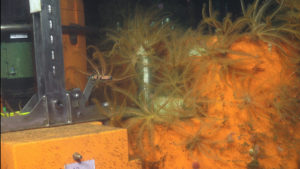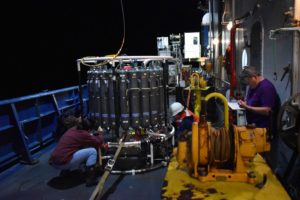Our first 24 hours at sea have been just as full as the last two days on shore. As of lunchtime on August 9th we had successfully ‘turned’ the shallow profiler moorings at Oregon Offshore (600 meters depth) and Slope Base (2900 m) sites. These ‘turns’ consist of three Jason dives each where old packages containing the controller computer and science pod (which during normal operations moves up and down in the water to take measurements) are unhooked from the main mooring platform and returned to the ship while new packages are installed. These dives can be quite delicate with many moving parts. Jason goes into the water with the new and old equipment with very few breaks and must manipulate several latches and pins to unsecure the old packages and secure the new ones. Despite these being our first six dives, the RCA and Jason team have been servicing these moorings now for many years and have become old pros at the intricacies required to keep these custom-built workhorses of the RCA running.
The Leg 1 VISIONS’24 students have also been very busy with orientations, learning how to log, and getting their sealegs. They are becoming confident loggers in the Jason control van (annotating video, taking screen grabs, and managing data storage), as well as learning the ins and outs of operating a CTD. The CTD is a rosette of bottles as well as an instrument package used to collect water throughout the water column. The water samples collected by the rosette and the measurements from the instruments onboard are used to calibrate the Shallow Profiler sensors and are thus very important for quality assurance and quality control. The students are actively involved in preparing and recovering the CTD (opening and cocking bottles and making sure caps have been removed from instruments, handling taglines and recovery poles), taking samples with the CTD on its way through the water column, and sampling the water once the CTD has returned to the deck.
We will remain at Slope Base for the rest of the day, at least, to complete a few more operations here, before beginning our 18-hour transit to Axial Seamount. Those operations include swapping a junction box, testing and possibly swapping an ocean bottom seismometer, and collecting water with another CTD cast. We are hopping for a visit from ‘weird fish’, a ferocious mid-water predator that has very rarely been seen, except at Slope Base where it graces us with a visit most years.

Beautiful sea feathers on Offshore Shallow Profiler Mooring platform. UW/NSF-OOI/WHOI; J2-1603; V24.

Leg 1 VISIONS students sampling the CTD. Credit: A. Rose, University of Washington, V24.
Recent Updates